#south african issues
Explore tagged Tumblr posts
Text
Driving Corruption, Puzzling Zombies, Nightmarish Ogres, and Books Galore Await!
Hello, my Freaky Darlings! Salutations from the sunny side of Africa, where the weather matches our country’s knack for surprises. While I’m sipping sunshine, Cape Town is sipping tea under a drizzle. But, speaking of life in South Africa, my last blog post dove into a rather dark and damp topic – the slippery slope of corruption behind our alarmingly high road fatalities. If you missed it but…

View On WordPress
#Book deals#Corruption in South Africa#Current Events#Fantasy Fiction#Ogres and Monsters#South African Issues#Transport Sector Corruption#Word Puzzles#YouTube Videos#Zombie Novella
1 note
·
View note
Text
Sri Lankan Fairies and Senegalese Goddesses: Mixing Mythology as a Mixed Creator
[Note: this archive ask was submitted before the Masterpost rules took effect in 2023. The ask has been abridged for clarity.]
@reydjarinkenobi asked:
Hi, I’m half Sri Lankan/half white Australian, second gen immigrant though my mum moved when she was a kid. My main character for my story is a mixed demigod/fae. [...] Her bio mum is essentially a Scottish/Sri Lankan fairy and her other bio mum (goddess) is a goddess of my own creation, Nettamaar, who’s name is derived from [...] Wolof words [...]. The community of mages that she presided over is from the South Eastern region of Senegal [...] In the beginning years of European imperialism, the goddess basically protected them through magic and by blessing a set of triplets effectively cutting them off from the outside world for a few centuries [...] I was unable to find a goddess that fit the story I wanted to tell [...] and also couldn’t find much information on the internet for local gods, which is why I have created my own. I know that the gods in Hinduism do sort of fit into [the story] but my Sri Lankan side is Christian and I don’t feel comfortable representing the Hindu gods in the way that I will be this goddess [...]. I wanted to know if any aspect of the community’s history is problematic as well as if I should continue looking further to try and find an African deity that matched my narrative needs? I was also worried that having a mixed main character who’s specifically half black would present problems as I can’t truly understand the black experience. I plan on getting mixed and black sensitivity readers once I finish my drafts [...] I do take jabs at white supremacy and imperialism and I I am planning to reflect my feelings of growing up not immersed in your own culture and feeling overwhelmed with what you don’t know when you get older [...]. I’m sorry for the long ask but I don’t really have anyone to talk to about writing and I’m quite worried about my story coming across as insensitive or problematic because of cultural history that I am not educated enough in.
Reconciliation Requires Research
First off: how close is this world’s history to our own, omitting the magic? If you’re aiming for it to be essentially parallel, I would keep in mind that Senegal was affected by the spread of Islam before the Europeans arrived, and most people there are Muslim, albeit with Wolof and other influences.
About your Scottish/Sri Lankan fairy character: I’ll point you to this previous post on Magical humanoid worldbuilding, Desi fairies as well as this previous post on Characterization for South Asian-coded characters for some of our commentary on South Asian ‘fae’. Since she is also Scottish, the concept can tie back to the Celtic ideas of the fae.
However, reconciliation of both sides of her background can be tricky. Do you plan on including specific Sri Lankan mythos into her heritage? I would tread carefully with it, if you plan to do so. Not every polytheistic culture will have similar analogues that you can pull from.
To put it plainly, if you’re worried about not knowing enough of the cultural histories, seek out people who have those backgrounds and talk to them about it. Do your research thoroughly: find resources that come from those cultures and read carefully about the mythos that you plan to incorporate. Look for specificity when you reach out to sensitivity readers and try to find sources that go beyond a surface-level analysis of the cultures you’re looking to portray.
~ Abhaya
I see you are drawing on Gaelic lore for your storytelling. Abhaya has given you good links to discussions we’ve had at WWC and the potential blindspots in assuming, relative to monotheistic religions like Christianity, that all polytheistic and pluralistic lore is similar to Gaelic folklore. Fae are one kind of folklore. There are many others. Consider:
Is it compatible? Are Fae compatible with the Senegalese folklore you are utilizing?
Is it specific? What ethnic/religious groups in Senegal are you drawing from?
Is it suitable? Are there more appropriate cultures for the type of lore you wish to create?
Remember, Senegalese is a national designation, not an ethnic one, and certainly not a designation that will inform you with respect to religious traditions. But more importantly:
...Research Requires Reconciliation
My question is why choose Senegal when your own heritage offers so much room for exploration? This isn’t to say I believe a half Sri-Lankan person shouldn’t utilize Senegalese folklore in their coding or vice-versa, but, to put it bluntly, you don’t seem very comfortable with your heritage. Religions can change, but not everything cultural changes when this happens. I think your relationship with your mother’s side’s culture offers valuable insight to how to tackle the above, and I’ll explain why.
I myself am biracial and bicultural, and I had to know a lot about my own background before I was confident using other cultures in my writing. I had to understand my own identity—what elements from my background I wished to prioritize and what I wished to jettison. Only then was I able to think about how my work would resonate with a person from the relevant background, what to be mindful of, and where my blindspots would interfere.
I echo Abhaya’s recommendation for much, much more research, but also include my own personal recommendation for greater self-exploration. I strongly believe the better one knows oneself, the better they can create. It is presumptuous for me to assume, but your ask’s phrasing, the outlined plot and its themes all convey a lack of confidence in your mixed identity that may interfere with confidence when researching and world-building. I’m not saying give up on this story, but if anxiety on respectful representation is a large barrier for you at the moment, this story may be a good candidate for a personal project to keep to yourself until you feel more ready.
(See similar asker concerns here: Running Commentary: What is “ok to do” in Mixed-Culture Supernatural Fiction, here: Representing Biracial Black South American Experiences and here: Am I fetishizing my Japanese character?)
- Marika.
Start More Freely with Easy Mode
Question: Why not make a complete high-fantasy universe, with no need of establishing clear real-world parallels in the text? It gives you plenty of leg room to incorporate pluralistic, multicultural mythos + folklore into the same story without excessive sweating about historically accurate worldbuilding.
It's not a *foolproof* method; even subtly coded multicultural fantasy societies like Avatar or the Grishaverse exhibit certain harmful tropes. I also don't know if you are aiming for low vs high fantasy, or the degree of your reliance on real world culture / religion / identity cues.
But don't you think it's far easier for this fantasy project to not have the additional burden of historical accuracy in the worldbuilding? Not only because I agree with Mod Marika that perhaps you seem hesitant about the identity aspect, but because your WIP idea can include themes of othering and cultural belonging (and yes, even jabs at supremacist institutions) in an original fantasy universe too. I don't think I would mind if I saw a couple of cultural markers of a Mughal Era India-inspired society without getting a full rundown of their agricultural practices, social conventions and tax systems, lol.
Mod Abhaya has provided a few good resources about what *not* to do when drawing heavily from cultural coding. With that at hand, I don't think your project should be a problem if you simply make it an alternate universe like Etheria (She-Ra and the Princesses of Power), Inys (The Priory of the Orange Tree) or Earthsea (the Earthsea series, Ursula K. Le Guin). Mind you, we can trace the analogues to each universe, but there is a lot of freedom to maneuver as you wish when incorporating identities in original fantasy. And of course, multiple sensitivity readers are a must! Wishing you the best for the project.
- Mod Mimi
#asks#multiracial#multicultural#south asian#sri lankan#senegalese#west african#identity#representation#worldbuilding#fantasy#mythology#folklore#fairies#deities#adoption#identity issues#mixed experiences#coding
633 notes
·
View notes
Text
Imo the X-Men are at their best when they're doing queer allegory and at their worst when they're veering into sanitized idealized Zionism
#not saying they don't do race allegory well#and other forms of bigotry#but the metaphor often is usually the least muddled when it's queer#krakoa was so uncomfortable guys it was literally the “land without a people for a people without a land” myth taken at face value#and even Genosha in the new '97 show felt way more like Krakoa than the South African Apartheid metaphor Genosha originally was#the “final solution” to the “mutant issue” being not that discrimination is bad#but that they are a fundamentally different species than humans and inherently need to live separately to have peace#is not the progressive ideal happy ending that it tries to present itself as and just has so many uncomfy real world implications#x-men#x men#xmen#genosha#queer#politics#lgbt#lgbtq#palestine#free palestine
13 notes
·
View notes
Text
okay so that children of blood and bone cast reveal…..
#not many nigerians#which wouldn’t be an issue if they hadn’t kicked up a fuss about looking specifically for nigerian talent#but i’ll let it slide#ik how hollywood gets with casts and funding so ykw i’ll let it slide#south african lead#i’ll let it slide#light skinned amari????#KO LE WORK OOOOO#this one cannot slide#i’m not prepared for the accents we’re gonna hear#my head is already banging ooooo#children of blood and bone#children of blood and bone cast#children of virtue and vengeance#children of anguish and anarchy#cobab#covav#coaaa#tomi adeyemi
2 notes
·
View notes
Text
.
I'm not a patriotic person by any means, but there's no one more insufferable than a european or australian that shit talks america constantly. "your health care sucks" we know. "your education system sucks" we know. "blah blah blah insensitive jab about school shootings"
does that make you feel good, you insufferable, snobby little bitch?
#once again I'm not patriotic at all#I'm aware that america is in a state of utter shit#my issue with other people#usually brits#(not you british mutuals. ily)#talking shit about americans is that it's NEVER aimed at the government or anyone in power#it's always 'haha stupid american citizens don't know xyz'#which is absolutely rich when like 90% of the bullshit I've heard non-americans say when shit talking is just... factually incorrect#or based on a major double standards#like. making fun of someone or calling them ignorant for not knowing european geography is so weird#can YOU name every state. its capital. and also label it all on a map???#frankly. i bet more americans can label african/european/south american/etc countries than europeans that can label the 50 states#alisha babbles
3 notes
·
View notes
Text
No offence but it kind of sucks that the more fascist Musk gets the more South African he becomes in the eyes of the media
#like i get it ofc his history shaped who he is#but i just cant help but feel like all successes are a global north-only circle and all moral failures are for the global south to make#south africa being a scapegoat for why this man is so evil is like. not woke besties#hes american when he’s a tech genius but he’s south african when he’s a nazi… you guys are not being subtle#to be clear im not minimising the way he and his family benefitted from a crime against humanity#i just have an issue with south africa being dragged into the mud AGAIN for americans to point and sneer at
0 notes
Text
apex after midnight is hell … actual hell…
#gaming#gamers#text#psn#playstation#ps5#apex#apex legends#got called the R word at first by some South African probably annoyed they lost at cricket too…#no need for the abuse!!!#2nd lot were two guys calling me a little boy 🤡 then a crap teammate … get more mates? get a bigger willy? idk#absolute JOKE of a game with its hell hole fans#wish I never picked it up again#toxic teammates#why u trying to 2 v 4 ….#sounds like a skill issue not an us issue#how embarrassing for their mothers#they’ve got new modes and refresh or whatever it’s called for ranked …#and they’ve made it harder to report ppl … not that they actually care about ppl who play the games LOL#first r word as a diagnosed audhd … yea it hurts#might be a rubbish gamer but at least I’m not a rubbish person :)#honestly … stfu !!#no one English insulted me 👀
0 notes
Text
I'll never get over how FUNNY it was for me to be like
"I feel so sad and like I'm disconnected from black culture. People talk about all this stuff online and I have no relationship to it. I'm so upset that I feel like I'm not REALLY black because of this disconnect from black american culture. "
And my brother just being like
"Star."
"We're Canadian"
#i am. not the sharpest bulb in the drawer. ok?#ok for ppl not from north America#black american culture and black canadian culture is VERY VERY different.#like there are some historic black communities in canada from escaped slaves#but like.. idk the stats but id guess maybe around 90%? 85%? of black canadians#are people whose family immigrated any time between the 1950s to now.#which makes some STARK differences.#food for example.#theres not like. black canadian food.#theres jamaican food. and trinidadian food. and african food. etc.#but like in the states theres like a southern / black style of food#id argue black culture in canada is more similar in function to like south asian culture#where we recognise we all are the same and face the same issues with racism etc#but like. the food my grandparents made werent the food your grandparents made. ykwim?#a collective of people with similar experiences who dont share an ethnic background but who DO share a RACIAL background.
0 notes
Text

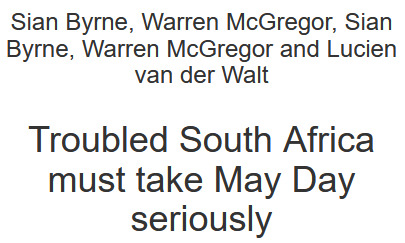
This is a time to embrace working-class unity and challenge the status quo of capitalist oppression.
May Day – a call to build an international movement of working class and poor people across lines of race, nation and religion for workers’ control and democracy from below, social justice and freedom from political and economic oppression – remains critical. In a country racked by anti-immigrant violence, racial and ethnic tensions, the fragmentation of the labour federation Cosatu, corporate scandals and political corruption, it is time to remember May Day’s roots and aspirations.
The day has become an institutionalised festival, yet its origins lie in powerful struggles for a united, anticapitalist, bottom-up, global justice movement, affirming the common interests of people, worldwide, against ruling elites and their divide-and-rule policies.
With the 2015 May Day set to be a showdown between South Africa’s rival union blocs, it is time to remember its roots and aims. Working-class unity is the only way to overcome problems such as class inequalities and national oppression in South Africa, a country ruled by the 1% and racked by periodic anti-immigrant violence.
Posing the problem as psychological – as in Police Minister Nathi Nhleko’s claim that recent violence is “Afrophobia” driven by “self-hate” – ignores attacks on Asian foreigners and assumes a natural state of African unity. It completely ignores the role of class and capitalist systems in which divisions between rich and poor, powerful and powerless, exist within races and nations. A Zimbabwean worker, a Pakistani worker and a South African worker have more in common with each other than any of them has with the Zimbabwean, Pakistani and South African upper class.
Ruling classes pit people against one another by means of economic policies that entrench historic inequalities, political mobilisation on the basis of race and nation by parties, states, ideologues and propaganda. Suburbs that are home to the black and white middle and upper classes sleep peacefully, far from the chaos and misery that arise from these policies, whereas the working class and poor turn on each other.
South Africa’s incomplete transition out of apartheid has left deep racial inequalities and national divisions. The legacy of apartheid and segregation is visible everywhere: the black, coloured and Indian working class and poor are doubly oppressed, by race and by class; the main political parties provide no solutions, but are part of the problem.
Radical changes are needed. Those proposed by the Federation of South African Trade Unions (Fosatu) and, before it, the International Socialist League (ISL), Industrial Workers of Africa and the International Working People’s Association (IWPA) include placing power, including self-managed control of the economy, into the hands of a multiracial working class and poor majority, rather than in parliaments or corporate boardrooms.
Changing statues will not address the issues. Indeed, political mobilisation of this sort, delinked from a radical programme of working-class rule, will simply reinforce the myriad divisions – immigrant versus national, race versus race, country versus country – that are the key to the power of the 1%.
Radical changes require a dynamic labour movement with a radical project, allied to other popular sectors altogether outside the party system and the electoral arena. These positions lie at the radical roots of May Day, which began as a commemoration of and protest against the 1887 execution of four IWPA anarcho-syndicalist labour organisers from Chicago.
One of them, August Spies, declared from the scaffold: “If you think that by hanging us, you can stamp out the labour movement – the movement from which the downtrodden millions, the millions who toil and live in want and misery – the wage slaves – expect salvation – if this is your opinion, then hang us! Here you will tread upon a spark, but there and there and behind you and in front of you and everywhere, flames will blaze up. It is a subterranean fire. You cannot put it out.”
Spies stressed popular self-emancipation: nonracial mass organisations to fight the state, capitalism and all forms of oppression and to establish a participatory, self-managed, democratic socialism, without state or corporate rule. This “Chicago idea” became part of the anarchist movement, especially in the Global South.
All states, all parties, were seen as betrayers of the working class, elections as futile choices between lying politicians – an insight many South Africans now accept. Even a workers’ party could not escape the logic of incorporation into a state machinery serving political and economic elites.
The IWPA practiced what it preached. IWPA militants such as the former slave Lucy Parsons, immigrants such as Spies and Samuel Fielden, and Americans such as Oscar Neebe and Albert Parsons led the main unions and working-class associations of Chicago, published radical newspapers and organised armed self-defence units. The IWPA took a leading role in a titanic 1886 general strike by black and white, immigrant and foreigner, centred on Chicago, and hence the organisation was targeted for repression. Eight IWPA militants were charged and four hanged.
In commemoration, the Socialist International, formed by anarchists, Marxists and others in 1889, launched May Day as a global day of action – in effect, it was to be a global general strike to build global labour unity.
May Day in South Africa started in the 1890s, among immigrant European workers. Early Witwatersrand events were whites-only affairs, ignoring the reality that the state felt no particular loyalty to white workers: more than 20 were shot down in the 1913 general strike, and martial law was used to suppress workers’ uprisings in 1914 and 1922.
An alternative May Day tradition emerged in 1904 from Cape Town, where local unions and the anarchist-led Social Democratic Federation (SDF) brought coloured and white workers together. The syndicalist ISL, formed in 1915, and Industrial Workers of Africa, formed in 1917, resolved to organise black workers, fight pass laws and secure complete equality through “one big union” fighting against segregation, capitalism and the state: the “Chicago idea” on the Highveld.
In 1917, the ISL organised a joint May Day rally in Johannesburg with the Transvaal Native Congress – the first local May Day with African speakers, including the ANC’s secretary general of the time, Horatio Mbelle. The Communist Party of South Africa, as it was then, continued the SDF-ISL tradition of May Day with a series of nonracial rallies to oppose race and class oppression. In 1922, the communist party demanded May Day become a paid public holiday, a demand taken up by the syndicalist-influenced black and coloured Industrial and Commercial Workers Union of Africa.
Massive May Days were held from the 1920s onwards, but the tradition withered under apartheid repression. May Day was revived by the South African Congress of Trade Unions in the 1950s and by the new unions of the 1970s. By the mid-1980s, May Day was again a day of mass action, as pushed by Fosatu and then Cosatu.
But, if the tragic origins of May Day are still commemorated today, its grander aspirations remain unfulfilled. The enormous power of a united working class remains shackled.
Labour-led organisations achieved surprising victories in difficult and divided contexts. These movements provide a resource base for ideas and strategies. By specifically organising among immigrants and by focusing on issues that disproportionately affected some groups of workers (racial oppression, for example), they built working-class counter-power, counterculture and solidarity.
This is a far cry from the situation today. The Cosatu labour movement has not succeeded in addressing its internal divisions. Indeed, its alliance with the ANC and the South African Communist Party has led to numerous splits, from the attack on figures opposed to President Jacob Zuma, such as then-president Willie Madisha, by Zwelinzima Vavi in 2007, to the expulsion of the National Union of Metalworkers of South Africa (Numsa) from Cosatu on the flimsiest grounds.
Within South Africa’s borders, ANC-driven neoliberal policies such as the Growth, Employment and Redistribution strategy and the National Development Plan have deepened poverty and inequality, creating a breeding ground for tensions on all sides. Regionally, South Africa is an imperialist power, deploying its superior economic power and military and political muscle across the continent, alongside the expansion of private and state-owned corporations in Africa.
South African military actions in the Central African Republic and the Democratic Republic of Congo from 2013 onwards are protecting ANC-linked businesses. South African silence on corrupt candidates in fraudulent elections (the DRC in 2001, Nigeria in 2007, Zimbabwe in 2011) is governed by crude ruling-class interests.
This cannot be separated from South African contempt for fellow Africans and attitudes to the rest of Africa.
Numsa’s return to a radical project, with some roots in Fosatu, its break with the tripartite alliance and its formation of a United Front revives the original spirit of the movements and struggles that made May Day. Let us hope Numsa carries forward the radical spirit of May Day by way of bottom-up, participatory trade unions at a distance from Parliament, capitalism and the state. May Day needs to be linked back to its radical roots, its one-time internationalism and the vision of an inclusive socialism from below.
#May Day#South Africa#labor#South African politics#anarchism#resistance#autonomy#revolution#community building#practical anarchism#anarchist society#practical#anarchy#daily posts#communism#anti capitalist#anti capitalism#late stage capitalism#organization#grassroots#grass roots#anarchists#libraries#leftism#social issues#economics#anarchy works#environmentalism#environment#anti colonialism
1 note
·
View note
Text
South Africa’s Minister of International Relations and Cooperation Naledi Pandor said that nationals who have served in the Israeli army will be prosecuted upon re-entering the country, as Israel continues its devastating war on the Gaza Strip for the sixth month. "I've already issued a statement alerting those who are South African and who are fighting alongside or in the Israeli Defense Force. We are ready. When you come home, we're going to arrest you," Pandor said during an African National Congress meeting earlier this week.
#yemen#jerusalem#tel aviv#current events#palestine#free palestine#gaza#free gaza#news on gaza#palestine news#news update#war news#war on gaza#south africa#fuck the idf#war crimes#naledi pandor
10K notes
·
View notes
Text
Oh the good old days of 2016. Back when every day for a solid month my mom would tell me not to download a challenge app about blue whales because a pedophile was going to force me to kill myself...
#This is either the most South African sentence I've ever typed up to this far#Or its just been so long that I can't remember if this was a universal issue or not#Apparently the Russians struggled with it so idk#I was in third grade. cut me some slack
0 notes
Text
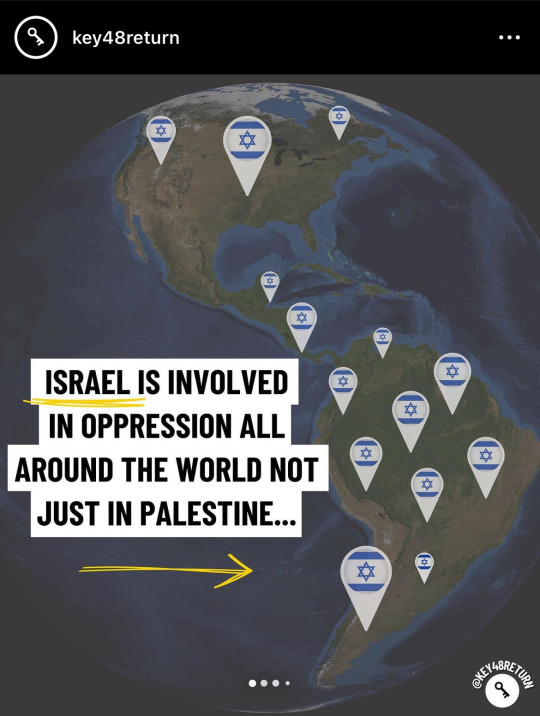
ID 1: Screenshot of a post by @/key48return on Instagram. Background is of a globe with pinpoints of the israeli flag all over North and South America. Title reads in all caps, “israel is involved in oppression all over the world not just in Palestine…” A yellow arrow points right underneath the title. End ID
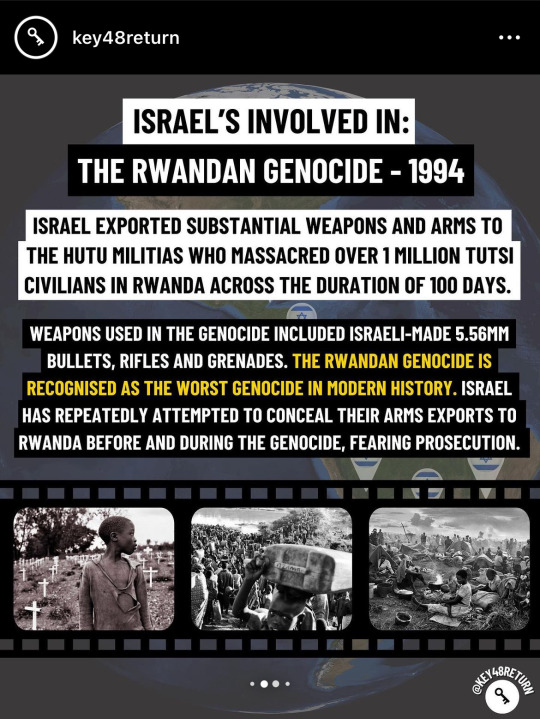
ID 2: In all caps, “ISRAEL'S INVOLVED IN:
THE RWANDAN GENOCIDE - 1994
ISRAEL EXPORTED SUBSTANTIAL WEAPONS AND ARMS TO THE HUTU MILITIAS WHO MASSACRED OVER 1 MILLION TUTSI CIVILIANS IN RWANDA ACROSS THE DURATION OF 100 DAYS.
WEAPONS USED IN THE GENOCIDE INCLUDED ISRAELI-MADE 5.56MM BULLETS, RIFLES AND GRENADES. THE RWANDAN GENOCIDE IS RECOGNISED AS THE WORST GENOCIDE IN MODERN HISTORY. ISRAEL HAS REPEATEDLY ATTEMPTED TO CONCEAL THEIR ARMS EXPORTS TO RWANDA BEFORE AND DURING THE GENOCIDE, FEARING PROSECUTION.”
Black and white photos below are shown of various Rwandan children in graveyards or in makeshift tents just trying to get by. End ID.
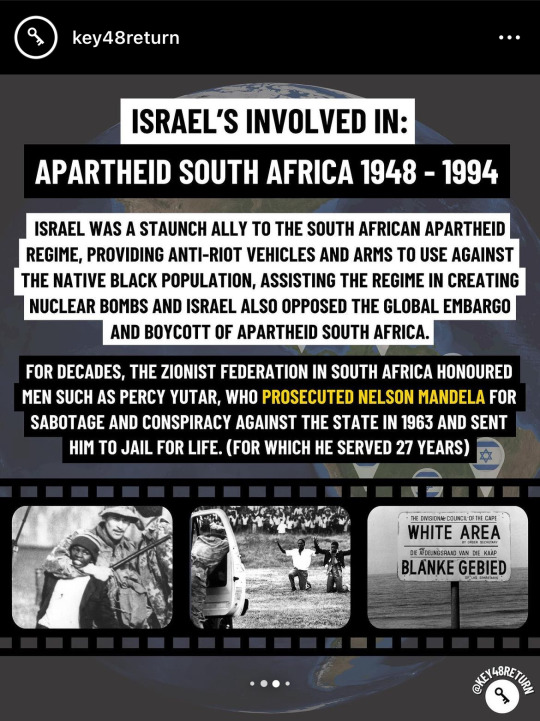
ID 3: In all caps, “ISRAEL'S INVOLVED IN:
APARTHEID SOUTH AFRICA 1948 - 1994
ISRAEL WAS A STAUNCH ALLY TO THE SOUTH AFRICAN APARTHEID REGIME, PROVIDING ANTI-RIOT VEHICLES AND ARMS TO USE AGAINST THE NATIVE BLACK POPULATION, ASSISTING THE REGIME IN CREATING NUCLEAR BOMBS AND ISRAEL ALSO OPPOSED THE GLOBAL EMBARGO AND BOYCOTT OF APARTHEID SOUTH AFRICA.
FOR DECADES, THE ZIONIST FEDERATION IN SOUTH AFRICA HONOURED MEN SUCH AS PERCY YUTAR, WHO PROSECUTED NELSON MANDELA FOR SABOTAGE AND CONSPIRACY AGAINST THE STATE IN 1963 AND SENT HIM TO JAIL FOR LIFE. (FOR WHICH HE SERVED 27 YEARS)”
Black and white photos below showcase a Black man being held in a chokehold by a white man, two Black people on their knees and hands up trying not to get shot, and a sign that reads in english and afrikaans “white area.” End ID.
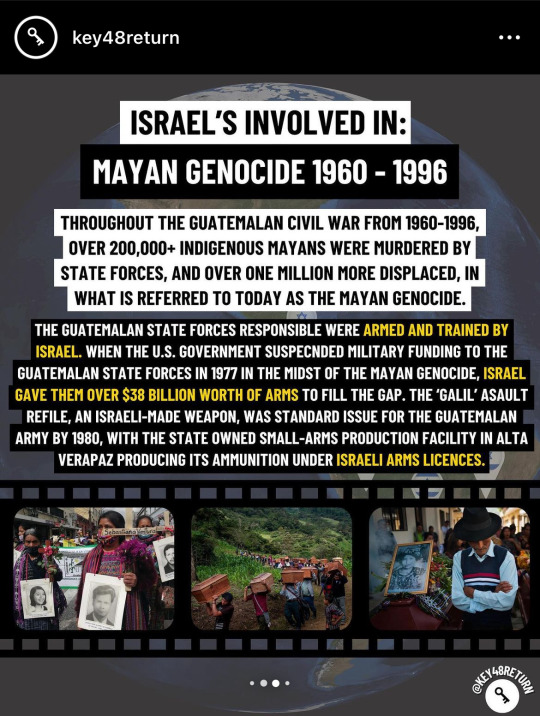
ID 4: In all caps, “ISRAEL'S INVOLVED IN:
MAYAN GENOCIDE 1960 - 1996
THROUGHOUT THE GUATEMALAN CIVIL WAR FROM 1960-1996, OVER 200,000+ INDIGENOUS MAYANS WERE MURDERED BY STATE FORCES, AND OVER ONE MILLION MORE DISPLACED, IN WHAT IS REFERRED TO TODAY AS THE MAYAN GENOCIDE.
THE GUATEMALAN STATE FORCES RESPONSIBLE WERE ARMED AND TRAINED BY ISRAEL. WHEN THE U.S. GOVERNMENT SUSPENDED MILITARY FUNDING TO THE GUATEMALAN STATE FORCES IN 1977 IN THE MIDST OF THE MAYAN GENOCIDE, ISRAEL GAVE THEM OVER $38 BILLION WORTH OF ARMS TO FILL THE GAP. THE 'GALIL' ASAULT RIFLE, AN ISRAELI-MADE WEAPON, WAS STANDARD ISSUE FOR THE GUATEMALAN ARMY BY 1980, WITH THE STATE OWNED SMALL-ARMS PRODUCTION FACILITY IN ALTA VERAPAZ PRODUCING ITS AMMUNITION UNDER ISRAELI ARMS LICENCES.”
Below are multiple in-color photos of Mayan families mourning, one photo in particular which shows indigenous Mayans carrying a seemingly endless line of coffins off into the distance. End ID.
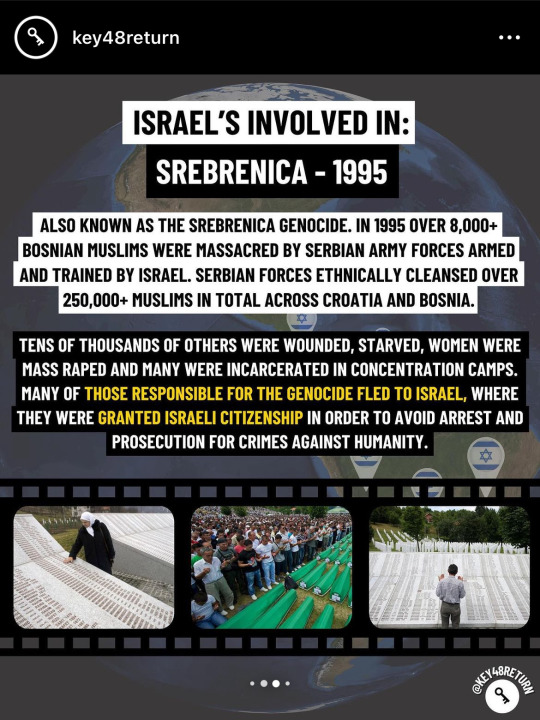
ID 5: In all caps, “ISRAEL'S INVOLVED IN:
SREBRENICA - 1995
ALSO KNOWN AS THE SREBRENICA GENOCIDE. IN 1995 OVER 8,000+ BOSNIAN MUSLIMS WERE MASSACRED BY SERBIAN ARMY FORCES ARMED AND TRAINED BY ISRAEL. SERBIAN FORCES ETHNICALLY CLEANSED OVER 250,000+ MUSLIMS IN TOTAL ACROSS CROATIA AND BOSNIA.
TENS OF THOUSANDS OF OTHERS WERE WOUNDED, STARVED, WOMEN WERE MASS RAPED AND MANY WERE INCARCERATED IN CONCENTRATION CAMPS. MANY OF THOSE RESPONSIBLE FOR THE GENOCIDE FLED TO ISRAEL, WHERE THEY WERE GRANTED ISRAELI CITIZENSHIP IN ORDER TO AVOID ARREST AND PROSECUTION FOR CRIMES AGAINST HUMANITY.”
Once again, the in-color photos below show various peoples mourning. Two of the photos specifically show people reaching their hands out over extremely long lists of just names of people who have died. End ID.

ID 6: In all caps, “ISRAEL'S INVOLVED IN:
TRAINING U.S. POLICE
SINCE 1990, HUNDREDS OF AMERICAN POLICE OFFICERS, INCLUDING AGENTS FROM THE FBI, CIA AND IMMIGRATION AND CUSTOMS ENFORCEMENT (ICE), HAVE EITHER BEEN SENT TO ISRAEL THROUGH POLICE TRAINING EXCHANGES, OR ATTENDED SUMMITS WITHIN THE U.S. THAT WERE SPONSORED BY ISRAELI LOBBY ORGANISATIONS.
THE KNEE-TO-NECK 'RESTRAINT' THAT DEREK CHAUVIN MURDERED GEORGE FLOYD WITH, IS OFTEN USED BY ISRAELI POLICE AND SOLIDERS AGAINST PALESTINIANS.
BLACK LIVES MATTER.”
Photos below are in-color and show various B.L.M. protests. End ID.
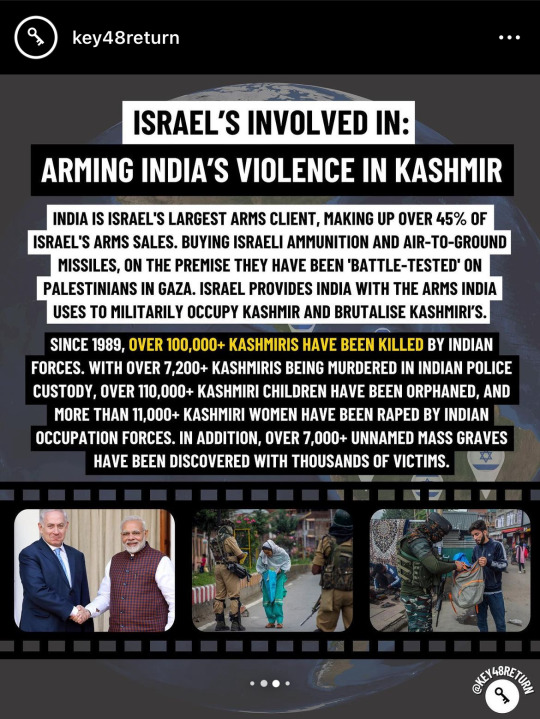
ID 7: In all caps, “ISRAEL'S INVOLVED IN:
ARMING INDIA'S VIOLENCE IN KASHMIR
INDIA IS ISRAEL'S LARGEST ARMS CLIENT, MAKING UP OVER 45% OF ISRAEL'S ARMS SALES. BUYING ISRAELI AMMUNITION AND AIR-TO-GROUND MISSILES, ON THE PREMISE THEY HAVE BEEN 'BATTLE-TESTED' ON PALESTINIANS IN GAZA. ISRAEL PROVIDES INDIA WITH THE ARMS INDIA USES TO MILITARILY OCCUPY KASHMIR AND BRUTALISE KASHMIRI'S.
SINCE 1989, OVER 100,000+ KASHMIRIS HAVE BEEN KILLED BY INDIAN FORCES. WITH OVER 7,200+ KASHMIRIS BEING MURDERED IN INDIAN POLICE CUSTODY, OVER 110,000+ KASHMIRI CHILDREN HAVE BEEN ORPHANED, AND MORE THAN 11,000+ KASHMIRI WOMEN HAVE BEEN RAPED BY INDIAN OCCUPATION FORCES. IN ADDITION, OVER 7,000+ UNNAMED MASS GRAVES HAVE BEEN DISCOVERED WITH THOUSANDS OF VICTIMS.”
The photos below show israel and india’s leaders shaking hands and various armed indian soldiers stopping Kashmiris for unnecessary checks. End ID.
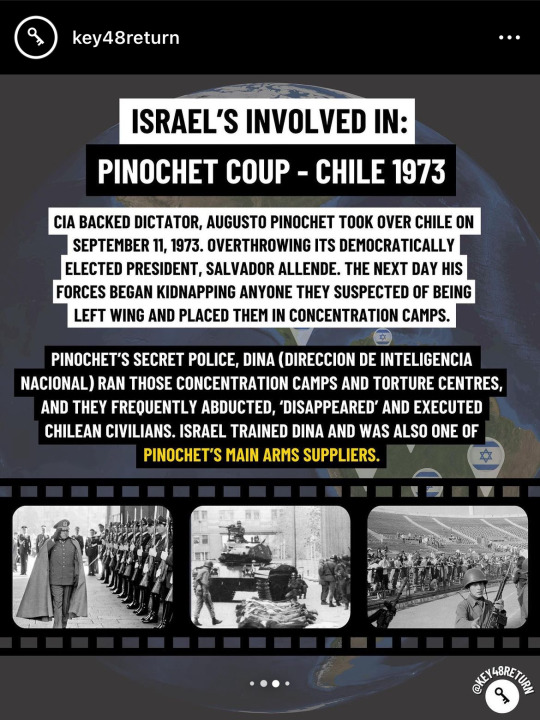
ID 8: In all caps, “ISRAEL'S INVOLVED IN:
PINOCHET COUP - CHILE 1973
CIA BACKED DICTATOR, AUGUSTO PINOCHET TOOK OVER CHILE ON SEPTEMBER 11, 1973. OVERTHROWING ITS DEMOCRATICALLY ELECTED PRESIDENT, SALVADOR ALLENDE. THE NEXT DAY HIS FORCES BEGAN KIDNAPPING ANYONE THEY SUSPECTED OF BEING LEFT WING AND PLACED THEM IN CONCENTRATION CAMPS.
PINOCHET'S SECRET POLICE, DINA (DIRECCION DE INTELIGENCIA NACIONAL) RAN THOSE CONCENTRATION CAMPS AND TORTURE CENTRES, AND THEY FREQUENTLY ABDUCTED, 'DISAPPEARED' AND EXECUTED CHILEAN CIVILIANS. ISRAEL TRAINED DINA AND WAS ALSO ONE OF PINOCHET'S MAIN ARMS SUPPLIERS.”
Black and white photos below showcase various scenes of armed DINA officers, with one photo in particular showing them in a tank over bodies on the ground, presumably dead. End ID.
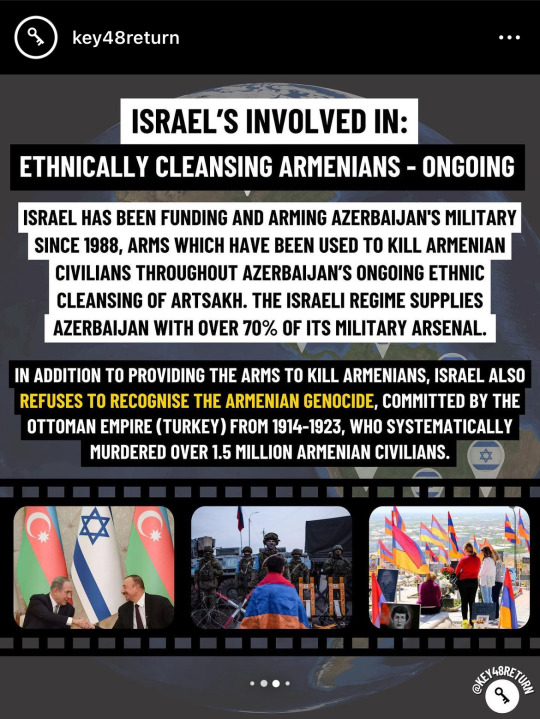
ID 9: In all caps, “ISRAEL'S INVOLVED IN:
ETHNICALLY CLEANSING ARMENIANS - ONGOING
ISRAEL HAS BEEN FUNDING AND ARMING AZERBAIJAN'S MILITARY SINCE 1988, ARMS WHICH HAVE BEEN USED TO KILL ARMENIAN CIVILIANS THROUGHOUT AZERBAIJAN'S ONGOING ETHNIC CLEANSING OF ARTSAKH. THE ISRAELI REGIME SUPPLIES AZERBAIJAN WITH OVER 70% OF ITS MILITARY ARSENAL.
IN ADDITION TO PROVIDING THE ARMS TO KILL ARMENIANS, ISRAEL ALSO REFUSES TO RECOGNISE THE ARMENIAN GENOCIDE, COMMITTED BY THE OTTOMAN EMPIRE (TURKEY) FROM 1914-1923, WHO SYSTEMATICALLY MURDERED OVER 1.5 MILLION ARMENIAN CIVILIANS.”
Photos below show israel and azerbaijan’s leaders shaking hands, azerbaijan’s soldiers menacingly standing in front of someone wrapped in an Armenian flag, and Armenians mourning over a shrine with their flags all around them. End ID.

ID 10: In all caps, “THE PALESTINIAN STRUGGLE FOR FREEDOM IS CONNECTED TO STRUGGLES ALL AROUND THE WORLD.
BECAUSE OPPRESSORS LIKE ISRAEL ARE NOT ONLY UPHOLDING OPPRESSION AGAINST ONE POPULATION, ITS ALWAYS INTERCONNECTED TO OPPRESSING MANY MORE.
FREE PALESTINE.” No photos at the bottom of this slide. End ID.
#reaux speaks#oppression#genocide#ethnic cleansing#apartheid#israel#palestine#free palestine#black lives matter#history#rwanda#africa#south africa#nelson mandela#mayans#guatemala#srebrenica#muslim#police brutality#kashmir#india#narendra modi#benjamin netanyahu#augusto pinochet#chile#armenia#artsakh#azerbaijan#bosnia#serbia
3K notes
·
View notes
Text
I wanted to explore the idea of people who dislike C3 not engaging with its themes because I haven't actually seen anyone making the argument give a full rundown of said themes, and this may end up being several posts. I'd like to start with anticolonialism. Perhaps it is a theme; if so, I think it's presented exceptionally badly, in a way that appeals uniquely to white westerners desiring to see themselves as a combination of victim and savior, rather than as a complex issue in a story centering the colonized. It got very long, so it's under a cut.
If this is the theme with which we as the viewers are not engaging, I'd argue neither is the work itself - it's largely projection. As many others have pointed out, the use of Marquet, a setting inspired by Africa and Asia (and presented in a highly stereotyped and Orientalist way in Campaign 1 no less) as nothing more than a casual backdrop with little engagement with the cultures present, and with much of the story elsewhere, undercuts that badly. I'd actually argue this is a recurring issue with Critical Role's works; Ank'Harel appears and is even fleshed out more in Call of the Netherdeep, but the story follows, and mostly takes place, among the Calamity-era ruins being excavated and amid faction squabbles concerning them. The culture and politics of Ank'Harel remain a distant second to the greater mythology of the Calamity, and again, after the society and culture and everyday people of the more European-inspired Wildemount took such a front seat in Campaign 2, it seems like a worrying pattern. Given the increased sensitivity and investment towards the cultures based on those in our own world that (for the most part) did the colonizing, and the "set-dressing", as others have called it, status of Marquet, perhaps this world is not a good one to tell that story. What's also interesting, and telling, is that the African and Asian - especially West, South, and Southeast Asian - was even a defense within the fandom: the reason so few of Bells Hells were from Marquet, we were told, is because the cast is white. In that case, and given how Marquet is so poorly integrated into the story that multiple beats relying on knowledge of the Apex War fall flat, why didn't we set this in Issylra (notably, the continent in which modern, mortal-driven occupation efforts are occurring)? And more importantly why are we trusting a group nearly entirely made of white culturally Christian Americans to tell what is argued to be an exceptionally leftist story on religiously-motivated colonialism if we can't even trust them to play a character from a real-world culture heavily impacted by said colonialism?
Another rather significant wrinkle is the fact that those wishing to release Predathos in the service of destroying the gods were happily working with the Kreviris Imperium, who desired to colonize Exandria. Remember how everyone was just talking about how the poor Ruidians would die if the planet were destroyed and how they're the victims in all this (and honestly, I don't disagree that the commoners of Ruidus, especially those without psychic powers, have a uniquely rough deal) when the planet cracks? Well, let's talk that through. I think the role of the Vanguard's Ruidusborn in this is rather important, ie, if they are throwing off the colonialism of the gods (to be discussed later whether I consider that valid), they are doing so by stepping on the necks of the common people of Ruidus. And if those people will be doomed by the release of Predathos, it is Bells Hells who doomed them.
The people of Ruidus were told of their manifest destiny of the Blue Promise by their governing body (which also served, effectively, as religious leadership, with mind control). I think "Propaganda" is a poor real-world metaphor for "sends dreams of the land promised to you each night, making you both jealous of what they have and very much influenced by their culture, while you have no dreams of your own" but it's the best I have, but that itself occupies an interesting space. It's a great beat for sf, but this actually leads to a rather worrisome metaphor regarding the nature of cultural influence (which was spoken of on a 4-sided Dive and is often cited here, and I think the way it's discussed fails to consider the implications). The idea of cultural hegemony and globalization is a very real one. It can occur within one's country (I, a non-Christian American, am well acquainted with many Christmas songs and traditions and am given Christian holidays off work but must use vacation for my own). It can also occur outside of it, as with globalized beauty standards - white ideas of beauty leading to light skin being prioritized in India, or double-eyelid surgery becoming common in South Korea. The situation on Ruidus therefore has some interesting implications. What does it mean for them to have inherited culture from Exandria - but at the hands of their own government that seeks to colonize Exandria? Is this a good way to explore these topics, when Exandrians are neatly excluded from the spread of their own cultural hegemony (as they had no idea) and are also poised to become the victims in this colonization? This idea, incidentally - that the people of Exandria exist in an impossible in-between space in the colonization metaphors, blameless victim yet free from the ugliest consequences of being a colonized culture - will recur, and I think that is the most damning evidence that this is at best a story of anticolonialism stripped of nuance and complexity.
In a further exploration of the cultural impact of colonialism, what does it mean that, again, I, Jewish from birth and raised in a Jewish home and sent, even, to a Jewish school through middle school (though not a Jewish preschool) have a pretty thorough knowledge of not just Christmas songs, but could probably name a bunch of individual Christian denominations and maybe even the intricacies in how they depict their crosses - while generally having freedom to practice my religion within the dominantly Christian US, if not equality in doing so - but Bells Hells, living under the presumed thumb of the gods, can't reliably tell their symbols or domains? Others have already covered this but if the gods are the dominant force, why have Bells Hells managed to largely avoid any actual consequences for godlessness other than "when I asked for something, I didn't get it?"
Why have all the governments we've seen, save Vasselheim (which, again - we haven't ever spent a ton of time in, so why did we go to Marquet again?) failed to convey religious dominance at the hands of the gods? The Clovis Concord, Tal'Dorei, Whitestone, Niirdal-Poc, Syngorn, and as far as I can tell Ank'Harel, Jrusar, Bassuras, Court of the Lambent Path, and the Stratos Throne (and if the latter isn't then Imogen and Ashton grew up in its borders without any religion forced upon them) are all secular governments that at most have outlawed Betrayer God worship. The Empire (in which Ludinus Da'leth has been a major political force for centuries) has strong restrictions on worship of all but six gods, and if you look at the first Tal'Dorei Campaign setting, it was at the timed conceived of as banning all deity worship. The Dynasty is a theocracy for a non-pantheon entity, engaging in missionary work but largely depicted as (if I may, oddly) devoid of violence. While Uthodurn's King Imathan Talviel is himself a worshiper of the Arch Heart, Uthodurn appears to have no state religion. Indeed, I'd say, as again, someone of a frequently persecuted religious minority, who lives in a country with a dark history of forced conversion of the native colonized people into Christianity [the Native American residential school system] I'd say that for a world in which the gods are objectively real? Exandrian governments are bizarrely lenient and bloodless when it comes to religion. Only the Dynasty even has a state religion of the aforementioned locations, and they don't even outlaw worship of non-Betrayer gods. The Empire, Concord, and Dynasty have, at most, fines or incarceration for worship of illegal deities. Hearthdell lost more people from their own attack and from the people teleported away by the solstice than from the missionary work; you think the might of Vasselheim couldn't have slaughtered the entire town if they went in? The only places we know of as even possibly more brutal are the Betrayer-worshiping Iron Authority, which remains vague and undescribed (weirdly, actually, given that the Crown Keepers might have gone there in the time between EXU Prime and Bells Hells); and Aeor (execution by hanging for deity worship).
I am not saying that any outlawing of religious worship (nor lack thereof) is a good thing, but we live in a world where people have - and still are - killed for gods for which we have, in my opinion, no proof of existence. It is unbelievably telling that the grievances provided (Tuldus, Ludinus, and members of Bells Hells) are all entirely individual experiences rather than anything systemic. It's people mad at their small communities or their parents, and that anger is valid, but it is immensely dangerous to take one's own individual negative experiences and treat it as systemic. This is the underlying motivation of how countless people are radicalized into hate groups (see: MRAs/incels, who are mostly mad at their mothers or at the fact that increased rights for women means women don't have to date or marry men if they don't want to - men are still the dominant class here, but their perceived individual slights and their extrapolation to this as systemic dominance of women is the radicalizing factor). The fact that Exandria has failed to set up a world where this is any sort of religious hegemony - Vasselheim is certainly important, but they aren't even a centralized governing body of worship a la the Catholic church, let alone a force outside of Othanzia, and are seen as an ally by the nonreligious Percy and Keyleth - again lethally undercuts the idea of this as anything but the most softened and childish discussion of colonialism and religion. Even Deanna's question to Pelor regarding Hearthdell reveals it as inaction - a failure to stop - rather than a command to act. It's at the level of how we teach American kindergarteners of the first Thanksgiving, except unless the entire narrative is wholly unreliable this is the actual story of Exandria. One giant pulled punch.
To quickly cover other items highly relevant to any sophisticated discussion of decolonialization/postcolonialism/colonialism in general that are absent from Campaign 3, and indeed Exandria as a whole: as multiple other fans have discussed, there is no concept of people of mixed race if the gods are the colonizers here. There is insufficient discussion of how, for example, many colonized or oppressed cultures have adopted western religions and see them as highly integral to their culture today - Catholicism in Central and South America and parts of Southeast Asia; Islam in other portions of Southeast Asia; Christianity within Africa and among African-Americans descended from slaves. This does not make the original forcing of said religion right or just; but any discussion of decolonization must account for the wants of those colonized, and I find that Campaign 3 fails to do so. The lack of meaningful conversation with common people across Exandria is something many of us have brought up. If we assume the members of the Accord are not necessarily speaking for those they rule, why do we have no concept of how the people at large of Whitestone, Gelvaan, Jrusar, Bassuras, Uthodurn, the Silken Squall, the Empire, the Dynasty, and the Tal'Dorei Republic feel? And if they are speaking for those they rule, well, we know how they feel.
I finally want to discuss that weird and, in my opinion, nonexistent irl space between actual colonizer and the colonized that mortals occupy. I personally reject the idea of the gods as colonizers given what we've seen in Downfall and because the metaphor is rather messy given the mythic scale. However, let's let treat them as such in this moment. Exandria was populated by titans. The lore is (possibly deliberately) vague and at times contradictory here, but either the titans lay dormant for a time after the gods arrived but before mortal society developed; or they lived in harmony with said mortals (who were created by the gods). They assisted, in some tellings, of the sealing of Predathos by the gods. They then, for unknown reasons, either awoke, or turned on the mortals; in the resulting schism they were killed and sealed by the Prime deities and the mortals. The Betrayer gods were those who wished to leave. The Betrayer gods too were sealed. The last known titans, sealed but not dead, were either destroyed or banished by the Ring of Brass during the start of the Calamity in order to prevent complete annihilation. The titans are now dead. Per Ashton's commune with them, there may be something that will rise again should the gods be eliminated; [only] the strong will survive it.
Questions to consider:
Why are a number of fans arguing that this story is one of anticolonialism so eager to place blame on Asmodeus and hope Predathos eats him first, when he is arguably the ringleader of those who most hoped to leave Exandria to the titans while they were still living? Do you hate the leader of the one most willing to decolonize? Or is the issue that this would also mean abandonment of the mortals, in which case, which is worse - destabilization or maintenance of a current situation (ie, the status quo)?
If the gods are colonizers, why isn't Predathos? It is no more a native of Exandria than they are. We know the gods were driven by an existential danger to their lives (which may or may not have been Predathos). Did Predathos lead the gods to Exandria and later corner them there, setting all of this in motion? Or is Predathos no different from them, driven to Exandria out of the need to survive? Given the titans opposed Predathos as well it is difficult to paint it as their savior (and the idea of an external savior of the colonized is, as discussed, one with unfortunate implications)? What is Predathos, and why is it better than the gods, if you believe it to be?
What are mortals here? They are not colonizer, nor are they native. I've discussed the (also very unfortunate) implications of treating sentient beings as ecology metaphors, but given that mortals truly did have, per the story, no agency in arriving on Exandria but were rather created here, are they akin to a non-native species? Such a species can be either invasive or beneficial, which fits with the idea of mortals being unique in their ability to change. Mortals were the ones under threat from the titans despite, again, being neither colonizer nor colonized; mortals participated in their destruction.
Where do the eidolons - seemingly unaffected by all of this - fit in? For a story about how change and newness might bring a better world, why the focus on the long-dead titans instead of the nature spirits that have seemingly taken their place? Why are many of Bells Hells constantly looking back and not forward?
And that last point feels particularly salient. The people of Exandria - a people whose opinion, again, in this campaign, it feels we have failed to explore - exist in an in-between state. They are more the heirs of the colonizers, in this assumption that the gods are colonizers, than the colonized. They cannot undo what the gods did. The gods can at this time only act through them.
What does it mean that we as the audience are intended to see ourselves most in a people who were not themselves those doing the colonizing, who are now under threat from colonization, and who might cooperate with the driving force behind that colonization? What does it say that our mortal viewpoint characters put more effort speaking to and for the dead than to the living? What does it tell us that many of them see themselves as the victims? What does it say that past campaigns had multiple characters subjected to actual systemic oppression (the twins, Jester, Molly, Veth-as-a-goblin, and Fjord all experienced racism) and explored the concept of the other (the Dynasty) and Campaign 3 never did? And when we add that to all of the above - that this world has failed to set up religion as even remotely close to both the meaningful and the oppressive force as it is in our own, despite the gods being real, that the grievances are individual and not systemic, that nearly all actions by the gods are motivated not by greed but by survival - is this an anti-colonialist work? Does it grapple with the problems of decolonialism meaningfully? Or does it let a white American viewer fantasize about a world where they are the oppressed, under threat of colonization, where their personal grievances are all forms of systemic oppression, cleansed of their own complicity in these systems, and where they can never be blamed for their actions because this is all so hard to choose- despite a far softer and gentler world than the one in which we actually live. And does it do so in a work they were going to watch anyway because they've been watching since well before this was introduced, thus permitting them to pretend they are experiencing a sophisticated anticolonialism narrative without having to go through the effort of actually reading that linked pdf of Orientalism they reblogged?
275 notes
·
View notes
Text

So George Soros dumped all of his Tesla stock, and the first thing Elon Musk does is start whining and boosting the posts of other white nationalists.
👉🏿 https://markets.businessinsider.com/news/stocks/george-soros-fund-dumps-entire-stake-tesla-elon-musk-2023-5

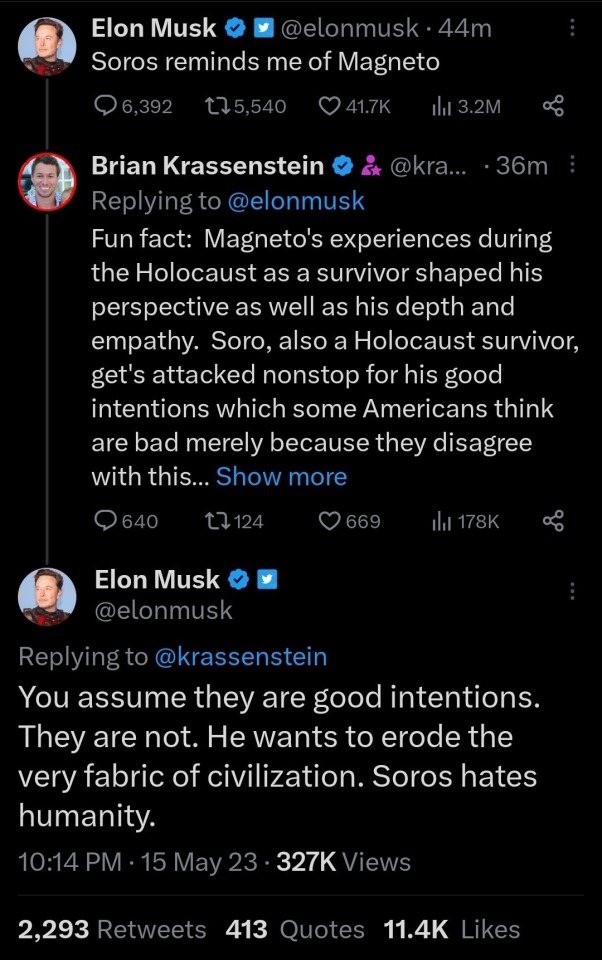
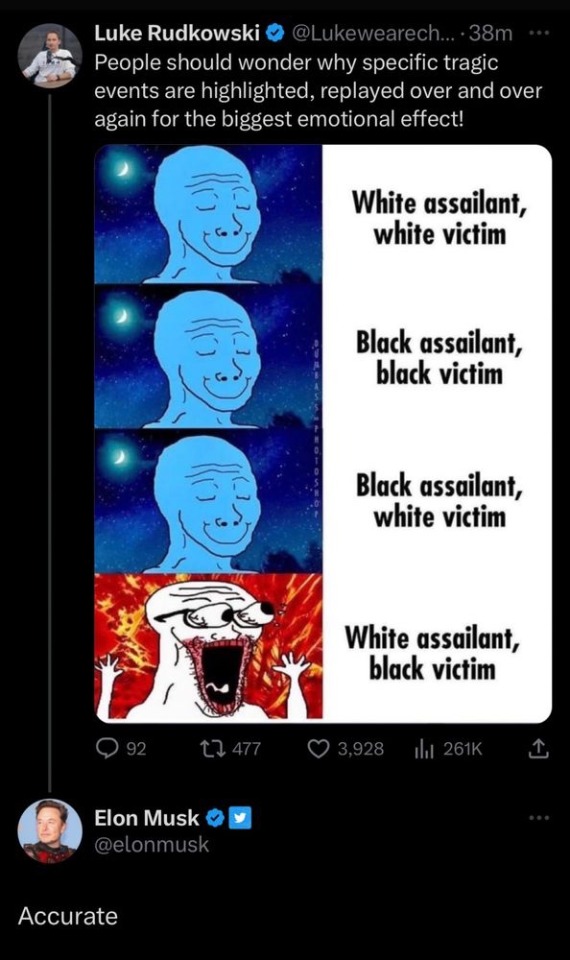
Weird how Elon Musk, the white South African billionaire who got his start from exploitative emerald mines, keeps amplifying the tweets of antisemites and anti-Black racists, huh?
Anyway, one thing that enduring Donald Trump for four years has taught me: whenever Elon starts making waves on Twitter, we should always start looking for whatever it is that he’s really trying to distract us from.
For example:
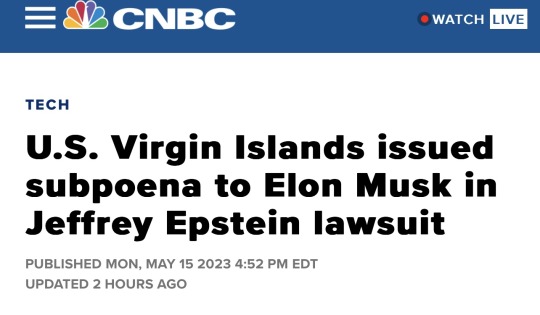

The U.S. territory asked Manhattan federal court Judge Jed Rakoff in the filing to allow it to serve Musk with the subpoena with Tesla's registered agent.
That subpoena demands Musk turn over any documents showing communication involving him, JPMorgan and Epstein, as well as “all Documents reflecting or regarding Epstein's involvement in human trafficking and/or his procurement of girls or women for consensual sex.”
👉🏿 https://www.cnbc.com/2023/05/15/us-virgin-islands-issued-subpoena-to-elon-musk-in-jeffrey-epstein-case.html
4K notes
·
View notes
Text
König at Parent Teacher Conferences
König is normally pretty used to intimidating people and putting those around him on edge. He tends to wear a balaclava in public to hide his heavy scarring, but he wonders how useful this is because it seems to make people just as worried. At the very least, they only seem to stare because of his height, not his face.
Unfortunately, there are some places where wearing a balaclava is inappropriate, and so he has to take it off. He usually knows the places, but one place he wasn't prepared to take off his mask was in front of his son's teacher.
Mrs. Coetzee's a good teacher, all things considered. She's not perfect, but she encourages his eldest son's interests and is always happy to provide plenty of updates to home. In all honesty, König thinks you should've gone to the parent-teacher conference and not him, but you insisted that you meet the old South African woman, telling him that Mrs. Coetzee was nice and friendly. You hadn't thought about the mask issue until he'd left, and by then you figured König could manage on his own.
When König first entered the room, Mrs. Coetzee had been stunned. She knew his kids were big, so she expected a larger father but she wasn't quite prepared for König having to duck under the door frame. In fact, she wasn't prepared for someone of his size at all. Her entire room was built for smaller children, not for giant military men. She was genuinely worried he'd break the chair he sat on when they sat across from each other.
König looked so out of place it was comical. If Mrs. Coetzee weren't so caught off guard she might have laughed herself. She wasn't laughing when König finally took off his mask.
She was obviously not prepared for König's face.
Mrs. Coetzee has met many people from all different backgrounds. She's used to seeing all sorts of people. She still struggles sometimes to place her students' faces to their parents'. With König, she feels like she's seeing a horrific future version of the young son. It's terrifying to see König's son all grown up with horrific war scars decorating his face. For a moment, Mrs. Coetzee can't help but stare in horror. She's not thinking that König looks ugly, she just can't help but think that this grizzled man was once an innocent little boy.
Mrs. Coetzee quickly clears her throat and goes through all the questions, but König is notably laconic. He's difficult to read. She's used to children being open and friendly, nothing like this veteran. She heard that König had been in the military, but nothing prepared her for this.
As the interview goes on, König gets notably more nervous. He tries to pay attention to what the little teacher is saying, but he can't help but notice her staring. He feels horrible about it. There's nothing he can do but endure, endure, endure. He just wants this over with, but she keeps asking more and more questions and he feels his resolve slowly breaking.
Once they're finally over, Mrs. Coetzee guides him to the door and waves him off with warm goodbyes. Mr. Henker is certainly no conversationalist, but he's friendly enough to get by.
Once König is long gone, Mrs. Coetzee goes and takes a seat at her desk and hangs her head in her hands. Suddenly, all the stories of the young Henker's father being a monster make so much more sense.
#konig#cod konig#konig cod#konig call of duty#konig mw2#konig x reader#konig x you#konig fluff#konig fanart#fan art#digital art#cod mw2#cod#cod mwii#cod x reader#call of duty#modern warfare#konig fanfiction#konig headcanons#cod headcanons#konig hcs#konig fanfic#konig childhood#konig relationship#konig shenanigans#konig art#konig au
205 notes
·
View notes
Text
On June 19, 1865, Union troops arrived in Galveston, Texas, and Major General Gordon Granger announced the end of the Civil War and that the enslaved people in the town were free. This was the last area in the South to receive the orders that slavery was abolished, and this announcement came over 2.5 years after President Abraham Lincoln issued the Emancipation Proclamation. What has become known as Juneteenth is now a federal holiday since 2021 and it is a symbolic date representing the African American struggle for freedom and equality in the United States and is also a celebration of family and community.
You might ask, what is important about Juneteenth to California history? Slavery was a major topic discussed at the California Constitutional Convention in September 1849. While California did enter the Union on September 9, 1850 as a “free state” as part of Congress’ Compromise of 1850, slavery did exist in California and there were certainly protections under the law that were not awarded to all people. Many enslaved people were brought to California during the Gold Rush.
Early Black civil rights leaders in Sacramento in the 1850s, such as Daniel Blue, Jeremiah B. Sanderson, William Yates, Charles Hackett, and Joseph Smallwood confronted political challenges and sought further representation in California in a time when a Person of Color could not testify against a white person in court. Early California newspapers were full of accounts of enslaved people paying for their freedom, testimonies by anti-slavery and civil rights activists, and stories covering plaintiffs suing for freedom. Elements of slavery continued in California through the Civil War.
The Emancipation Proclamation, General Granger’s announcement, and the 13th, 14th, and 15th Amendments to the U.S. Constitution after the Civil War did not solve issues of freedom and equality. The struggle of civil rights continued through the 20th Century and the extension of those rights to all people continues to this day.
For today, Jared letterpress printed “JUNETEENTH” in 30 line pica wood type. The typeface is French Clarendon and the type was made by the Hamilton Wood Type Company in the late 1880s. This was printed with yellow, red, and green ink using our Washington hand press, which was made in 1852.
#juneteenth#museum#sacramento#history#letterpress#printing#art#asmr#printmaking#old sacramento#oddly satisfying
619 notes
·
View notes